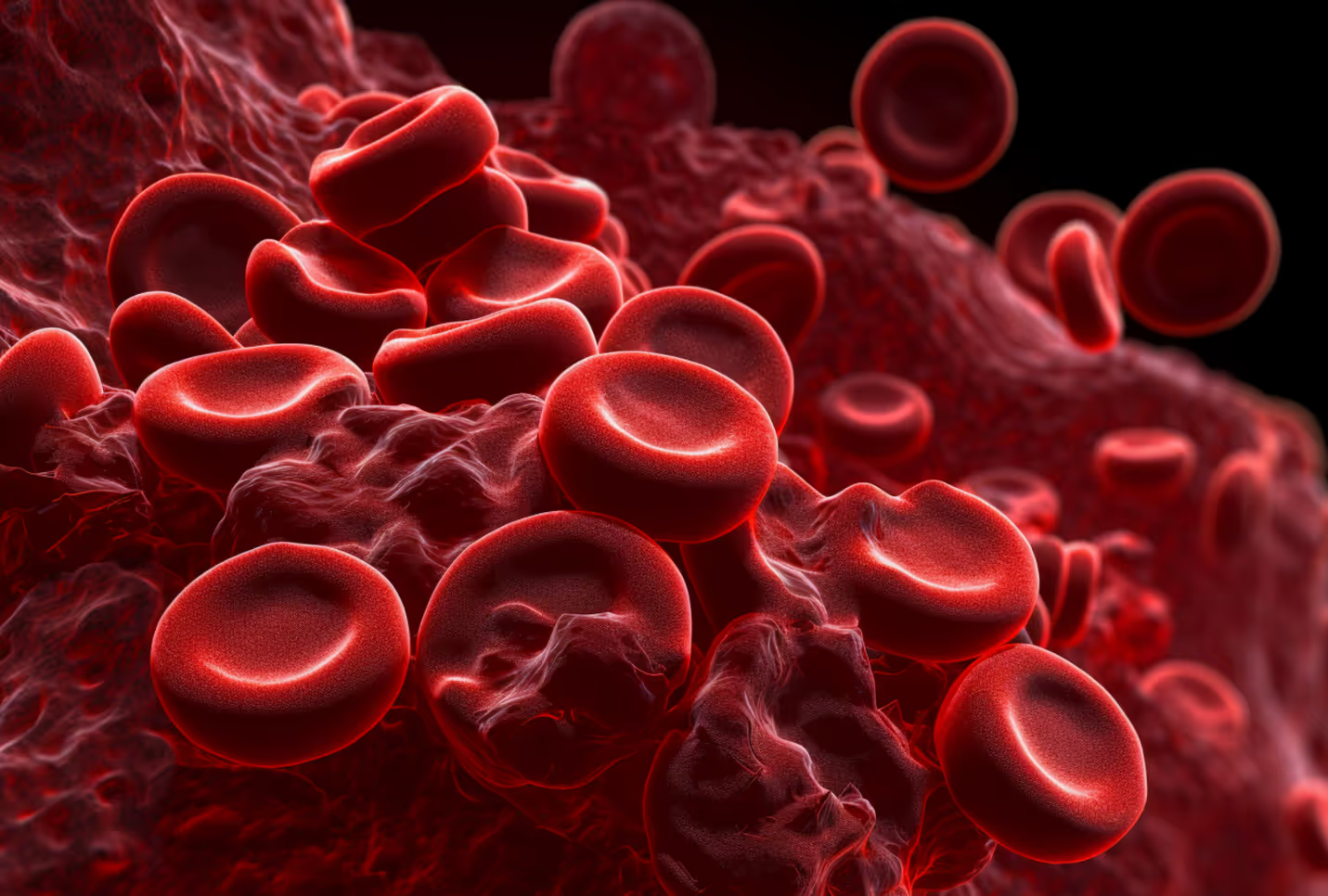
In the world of healthcare, understanding blood components is crucial, as it’s involved in virtually every bodily function. For example, hemoglobin is one of the more well-known components of blood, as it carries oxygen throughout our body.
Platelets might not be as well known, but they’re equally important, as they play a significant role in clotting and wound healing. But what happens when the platelet count in your blood is high?
This article explores the meaning behind a high platelet count, as well as its symptoms, causes, diagnosis, and treatment options.
From essential thrombocythemia to reactive thrombocytosis, we'll cover various conditions that can contribute to high platelet counts. We’ll also delve into the various diagnostic methods and currently available treatments.
Read on to expand your knowledge about this important aspect of blood health.
What Are Platelets?
Platelets, also called thrombocytes, are small colorless blood cells produced in the bone marrow. They play a vital role in the clotting process, preventing excessive bleeding.
Whenever a blood vessel is injured, platelets rush to the site and form a plug to stop the bleeding. Additionally, they release chemicals that promote clot formation and trigger the healing process.
Platelets are crucial for maintaining the integrity of our blood vessels and ensuring a healthy response to injury or trauma. When platelet levels are outside the normal range, it can indicate an underlying health condition that requires attention, such as a blood disorder or abnormal platelet function.
High platelet counts, a condition known as thrombocytosis, occur when there are excessive platelets in the blood. Understanding platelet function and the significance of high platelet counts can help identify potential health issues and guide appropriate medical interventions.
What Are High Platelet Counts?
Naturally, a high platelet count occurs when there is an excess number of platelets in the blood. A normal platelet count typically ranges between 150,000 and 450,000 platelets per microliter of blood.
When the count of blood platelets drops underneath this range, it is diagnosed as thrombocytopenia. When the count exceeds the range, it’s diagnosed as thrombocytosis.
Thrombocytosis can be classified into two types: primary thrombocytosis and secondary thrombocytosis.
Primary thrombocytosis, sometimes called essential thrombocytosis, is a rare disorder characterized by the overproduction of platelets in the bone marrow. When the cause of the high platelet count is unknown, then it’s typically referred to as essential thrombocythemia.
Secondary thrombocytosis, or reactive thrombocytosis, occurs as a result of an underlying condition or circumstance that stimulates increased platelet production. For instance, chronic myeloid leukemia (CML) is characterized by unusually high platelet counts.
What Are the Symptoms of a High Platelet Count?
In many cases, individuals with high platelet counts do not experience any noticeable symptoms. Thrombocytosis is often discovered incidentally during routine blood tests or tests performed for unrelated health concerns.
However, in some cases, certain symptoms may be present, particularly if the platelet count is extremely high or if an underlying condition is causing thrombocytosis.
Symptoms of a high platelet count can vary depending on the underlying cause and the severity of the condition. Some individuals may experience symptoms related to blood clotting, while others may have symptoms associated with the underlying condition itself.
Here are some common symptoms that may be observed:
Blood Clotting Symptoms
- Formation of blood clots in the arteries or veins
- Increased risk of high blood pressure, deep vein thrombosis (DVT), pulmonary embolism, and heart attack
- Persistent headaches or migraines
- Visual disturbances, such as blurred vision or changes in vision
- Redness, warmth, or swelling in the arms or legs
- Easy bruising or prolonged bleeding
Symptoms Related to Underlying Conditions
- Fatigue or weakness
- Enlarged spleen
- Joint pain or swelling
- Skin redness or itchiness
- Fever or night sweats
- Abdominal pain or discomfort
What Can Cause High Platelet Counts?
A high platelet count can be caused by various factors and conditions. Understanding the underlying causes is crucial for proper diagnosis and treatment.
Let's explore some common causes of high platelet counts.
Essential Thrombocytosis
As mentioned earlier, essential thrombocytosis (ET) is a bone marrow disorder characterized by the overproduction of platelets. It is considered a primary form of thrombocytosis.
In ET, there is a genetic mutation in the bone marrow cells responsible for platelet production. This mutation leads to uncontrolled platelet production, resulting in high platelet levels.
The exact cause of essential thrombocytosis is not fully understood, but genetic factors may play a role.
Reactive Thrombocytosis
Reactive thrombocytosis is a secondary form of thrombocytosis that occurs as a reaction to an underlying condition or situation. It is more common than essential thrombocythemia and often resolves once the underlying cause is treated.
Some common causes of reactive thrombocytosis include:
- Infections: Acute or chronic infections, such as pneumonia, tuberculosis, or viral infections, can stimulate the body to produce more platelets as part of the immune system response.
- Inflammatory conditions: Inflammatory disorders like rheumatoid arthritis, inflammatory bowel disease, or vasculitis can trigger platelet production.
- Surgery or trauma: After surgical procedures or physical trauma, the body may increase platelet production to aid in the healing process.
- Iron deficiency anemia: Severe iron deficiency can stimulate the bone marrow to produce more platelets.
- Hemolytic anemia: Conditions that cause the premature destruction of red blood cells can stimulate the bone marrow to produce more platelets.
- Medications: Certain medications, such as corticosteroids or epinephrine, can cause reactive thrombocytosis as a side effect.
Other Medical Conditions
In addition to essential thrombocythemia and reactive thrombocytosis, there are several other medical conditions that can contribute to high platelet counts:
- Polycythemia vera: This is a rare blood cancer that leads to an overproduction of red blood cells, white blood cells, and platelets.
- Myelofibrosis: Myelofibrosis is a chronic bone marrow disorder characterized by the abnormal accumulation of scar tissue, leading to decreased production of blood cells, including platelets.
- Lymphoma: Certain types of lymphoma, such as Hodgkin's lymphoma, can cause high platelet counts.
- Kidney disease: Chronic kidney disease can affect platelet production and lead to high platelet counts.
How Are High Platelet Counts Diagnosed?
To diagnose high platelet counts, a healthcare provider will typically start with a comprehensive evaluation, including medical history, physical examination, and blood tests.
They may also order the following diagnostic measures:
- Complete blood count (CBC): A CBC measures the number of platelets in the blood. A platelet count above the normal range indicates thrombocytosis.
- Blood smear: A blood smear allows for the examination of platelets under a microscope. It helps identify any abnormalities in the shape or size of platelets.
- Bone marrow biopsy: In some cases, a bone marrow biopsy may be performed to assess the bone marrow cells responsible for platelet production and to rule out underlying disorders like essential thrombocythemia or myelofibrosis.
- Genetic tests: In suspected cases of essential thrombocythemia, genetic tests may be conducted to detect mutations in specific genes, such as JAK2, CALR, or MPL.
How Are High Platelet Counts Treated?
The treatment approach for high platelet counts will vary depending on the underlying cause, severity of symptoms, and individual patient factors. The primary goals of treatment are to reduce the risk of blood clots and manage any associated symptoms.
Let's explore the common treatment options for high platelet counts.

Medications
Medications may be prescribed to help manage high platelet counts and prevent complications. Some commonly used medications include:
- Platelet-lowering drugs: These medications, such as hydroxyurea or anagrelide, work by suppressing the production of platelets in the bone marrow. They help to normalize platelet levels and reduce the risk of blood clotting.
- Antiplatelet drugs: Medications like aspirin may be recommended to inhibit platelet aggregation and prevent the formation of blood clots. However, the use of antiplatelet drugs should be carefully monitored and prescribed by a healthcare provider.
- Cytoreductive therapy: In cases of essential thrombocythemia or other myeloproliferative neoplasms, cytoreductive therapy may be recommended. These medications, such as hydroxyurea, interferon-alpha, or anagrelide, help to lower platelet production and prevent complications.
- Thrombopoietin receptor agonists: These medications, including romiplostim or eltrombopag, stimulate platelet production in cases of low platelet counts due to underlying conditions.
Lifestyle Modifications
In addition to medication, certain lifestyle modifications can help manage high platelet counts and reduce the risk of complications.
These may include:
- Diet and nutrition: A well-balanced diet that includes heart-healthy foods rich in vitamin b12 and omega-3 fatty acids, such as fatty fish, nuts, and seeds, can have antiplatelet and anti-inflammatory effects. Avoiding foods high in saturated fats and cholesterol is also recommended.
- Regular exercise: Engaging in regular physical activity can help improve overall cardiovascular health and promote healthy blood flow. However, it is important to consult with a healthcare provider before starting any exercise regimen, especially if there are underlying health conditions.
- Smoking cessation: Smoking increases the risk of blood clotting and cardiovascular complications. Quitting smoking is crucial in managing high platelet counts and reducing the risk of related complications.
- Stress management: Chronic stress can contribute to increased platelet activity. Implementing stress-reduction techniques, such as meditation, yoga, or relaxation exercises, can help manage stress levels and promote overall well-being.

The Bottom Line
High platelet counts can be caused by various factors and conditions, ranging from primary bone marrow disorders to reactive responses to underlying health conditions. Proper diagnosis and treatment are essential to manage high platelet counts and prevent complications. In many cases, high platelet counts can be effectively managed through a combination of medication and lifestyle modifications.
Working closely with healthcare providers and following their recommendations is crucial for optimal treatment outcomes. Remember, each individual's case is unique, and it's important to consult with a healthcare professional for personalized advice and guidance. If you’re seeking convenient and comprehensive cardiopulmonary care from the comfort of your own home, consider Carda Health's at-home virtual healthcare services.
Here at Carda Health, we offer personalized and accessible care for a range of cardiovascular and respiratory conditions. Through our virtual platform, you can connect with experienced healthcare providers, receive expert guidance, and access necessary resources for managing your condition.
Take control of your health from the comfort of your own home. Contact Carda Health today to learn more about our services and how we can support your healthcare needs.
Sources:
Hemoglobin: Structure, Function and Allostery | PMC
What Are Platelets and Why Are They Important? | Johns Hopkins Medicine
Thrombocyte | ScienceDirect Topics
What Is a Normal Platelet Count? | OneBlood
Thrombocytopenia: Symptoms, Stages & Treatment | Cleveland Clinic
Blood Clotting Disorders - Symptoms and Diagnosis | NHLBI
Platelet Disorders - Thrombocythemia and Thrombocytosis | NIH

.avif)






